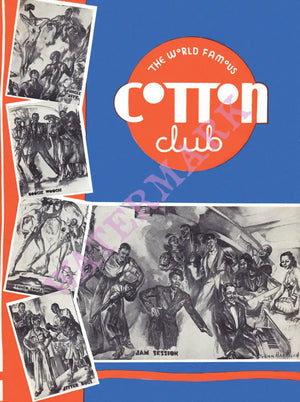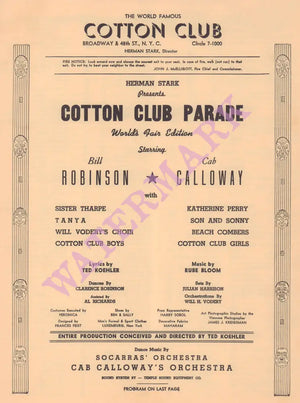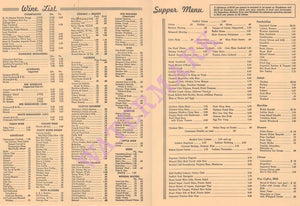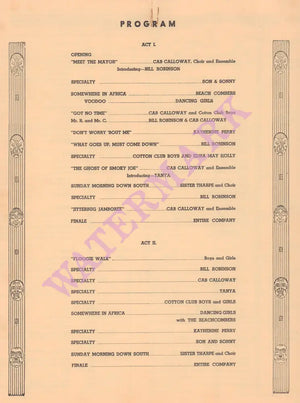
Cotton Club, New York 1930s
Free Shipping In The US
Cotton Club was the legendary jazz era nightspot in the Harlem district of New York City that featured many of the greatest African American entertainers of the 1920s and 30s.
It was established in 1923 when the white gangster and bootlegger Owney Madden got out of Sing Sing prison and bought a faltering supper club called Club De Luxe at 142nd Street and Lenox Avenue, owned by Jack Johnston, America’s first black heavyweight boxing champion.
The underworld figure initially wanted a place to sell his bootleg liquor during Prohibition and refurbished the place, christening it the Cotton Club. It became a ‘whites only’ speakeasy and employed black staff and performers.
In his biography, the jazz singer and bandleader Cab Calloway (1907-1994) described the décor of the Cotton Club:’ The stage set looked like a ‘Sleepy Time Down South’ stage set from the days of slavery. The bandstand was a replica of a southern mansion with large, white columns and a backdrop painted with weeping willows and slave quarters. The band played on the veranda. A few steps down was the dance floor, which was also used for floorshows.’
The Cotton Club flourished, despite its segregation policy. The American poet, novelist and social activist Langston Hughes, a leading voice of the Harlem Renaissance, visited the club and derided it as ‘a Jim Crow club for gangsters and monied whites.’
Dinner and dancing for the 700 wealthy white patrons started at 9pm and the club’s famous floor shows started at midnight, featuring revues called Cotton Club Parades and acts by singers, singers, vaudeville performers, comics, tap dancers, and chorus girls.
The club was a springboard for many black performers including Count Basie, Ella Fitzgerald. Louis Armstrong, Nat King Cole, Dizzy Gillespie, Billie Holliday and weekly radio broadcasts spread the fame of the club to a national audience.
In the 1930s, Duke Ellington was eventually able to persuade the club to relax its racist segregation policies and allow blacks to be admitted, although they were only permitted seats in the back of the club.
This Cotton Club menu was from the early 1930s and the lavish revues at that time featured Cab Calloway as leader of the in-house orchestra, tap dancer Bill ‘ Bojangles’ Robinson, who was the the highest paid black performer in the United States of the era, and singer and songwriter Sister (Rosetta) Tharpe whose gospel songs, characterized by a unique mixture of spiritual lyrics and electric guitar, are said to have influenced early rock n roll musicians such as Chuck Berry, Elvis Presley and Johnny Cash.
The Harlem race riot of 1935, precipitated by a teenager’s theft of a penknife from a store and fueled by economic hardship, racial injustice and mistrust of the police, was the beginning of the end of the Cotton Club.
In 1936, fearing white patrons were no longer safe in Harlem, the Cotton Club was moved to New York midtown theater district but closed permanently in 1940 due to factors including changing music tastes, competition in the entertainment scene and a tax evasion investigation
Each order includes a print of the interior menu.
All printed in USA.





